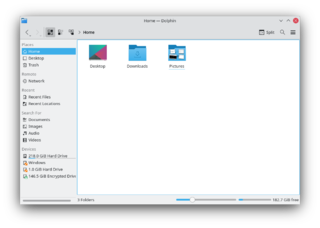Dolphin/zh-tw: Difference between revisions
Appearance
Updating to match new version of source page |
Updating to match new version of source page |
||
| (6 intermediate revisions by the same user not shown) | |||
| Line 2: | Line 2: | ||
{|class="vertical-centered" | {|class="vertical-centered" | ||
|[[ | |[[File:Dolphin.png|thumb|center|320px]]|| ||'''深藏不露的專用檔案管理員''' | ||
|} | |} | ||
<span id="Feature_Overview"></span> | |||
==特性概述== | ==特性概述== | ||
'''Dolphin''' is a lightweight file manager. It has been designed with ease of use and simplicity in mind, while still allowing flexibility and customization. This means that you can do your file management exactly the way you want to do it. You will find more information on how to handle '''Dolphin''' in this [[Special:myLanguage/Dolphin/File Management | tutorial]] or in the official [http://docs.kde.org/stable/en/applications/dolphin/index.html Handbook]. | |||
<div class="mw-translate-fuzzy"> | |||
* 易用並專門的檔案管理員 | |||
* 致力於可用性 | |||
* 「麵包屑」(Breadcrumb)導航列 | |||
* 提供可選的方便的導航和信息顯示面板 | |||
* 透過[[Glossary#KIO|KIO]]支持遠端和虛擬檔案系統的檔案管理 | |||
* 可標記檔案和資料夾 | |||
</div> | |||
初看,這是一個簡易的檔案管理員,但是它多才多藝。包括下列功能 | 初看,這是一個簡易的檔案管理員,但是它多才多藝。包括下列功能 | ||
| Line 26: | Line 31: | ||
::* 多數功能都支持鍵盤快捷鍵操作 | ::* 多數功能都支持鍵盤快捷鍵操作 | ||
<span id="Tutorials"></span> | |||
== 教學 == | == 教學 == | ||
:* [[Special:myLanguage/Dolphin/File Management#Discover Dolphin| | <div class="mw-translate-fuzzy"> | ||
:* [[Special:myLanguage/Dolphin/File_Management#File_System_Navigation| | :* [[Special:myLanguage/Dolphin/File Management#Discover Dolphin|發掘 Dolphin]] | ||
:* [[Special:myLanguage/Dolphin/File_Management#Archive_Management_in_Dolphin| | :* [[Special:myLanguage/Dolphin/File_Management#File_System_Navigation|檔案系統導航]] | ||
:* [[Special:myLanguage/Dolphin/ | :* [[Special:myLanguage/Dolphin/File_Management#Archive_Management_in_Dolphin|Dolphin 的壓縮管理]] | ||
:* [[Special:myLanguage/Dolphin/Batch_Rename|批量重命名多個檔案]] | |||
</div> | |||
== | <span id="Hints,_Tips_and_Troubleshooting"></span> | ||
==提示,技巧和疑難解答 == | |||
''' | '''Problem:''' When I choose the application to open a specific filetype with, it seems to affect other filetypes too. It’s like '''Dolphin''' cannot tell the difference between the ''two different filetypes''. | ||
:'''Solution:''' Probably the KDE platform does not know about one of the two filetypes, so it associates the filetype to a different, known filetype. This is common with XML-based filetypes; even if they use a file extension of their own (e.g. <tt>.xliff</tt> or <tt>.graphml</tt>), if they are not a filetype known by the KDE platform, they will be treated as any other XML file, and opened with the default application to open XML files. | |||
:To solve this issue, you can use [[Special:myLanguage/System Settings/File Associations|File Associations]] to [[Special:myLanguage/System Settings/File Associations#Adding new file types|create an entry for the unrecognized filetype]]. | |||
'''Problem:''' Dolphin's Find File service doesn't find files you know are on your computer. | |||
:'''Solution:''' Reindex [[Special:myLanguage/Baloo|Baloo]]. Baloo is a file indexing and search service that Dolphin uses to search for files. It needs to be indexed to work. To solve this problem, in a terminal type, <tt>balooctl check</tt> | |||
'''Problem:''' | '''Problem:''' There is no file transfer dialog. | ||
:'''Solution:''' | :'''Solution:''' As of KDE 5 jobs like file transfers are handled by default in centralized notification system; file transfer is also shown in task manager. To enable separate file transfer dialog disable file transfer tracking on both the System Tray notification area and the task manager plasmoid and re-login. | ||
<div class="mw-translate-fuzzy"> | |||
'''[http://dolphin.kde.org Dolphin 網站]'''和 '''[http://docs.kde.org/stable/en/kdebase-apps/dolphin/index.html Dolphin 手冊]''' 。 | |||
</div> | |||
<span id="Keywords"></span> | |||
== 關鍵詞 == | == 關鍵詞 == | ||
<div class="mw-translate-fuzzy"> | |||
檔案管理、檔案管理員、檔案瀏覽器、標記、元數據、Nepomuk | 檔案管理、檔案管理員、檔案瀏覽器、標記、元數據、Nepomuk | ||
</div> | |||
[[Category:Dolphin/zh-tw]] | [[Category:Dolphin/zh-tw]] | ||
Latest revision as of 04:38, 19 May 2024
 |
深藏不露的專用檔案管理員 |
特性概述
Dolphin is a lightweight file manager. It has been designed with ease of use and simplicity in mind, while still allowing flexibility and customization. This means that you can do your file management exactly the way you want to do it. You will find more information on how to handle Dolphin in this tutorial or in the official Handbook.
- 易用並專門的檔案管理員
- 致力於可用性
- 「麵包屑」(Breadcrumb)導航列
- 提供可選的方便的導航和信息顯示面板
- 透過KIO支持遠端和虛擬檔案系統的檔案管理
- 可標記檔案和資料夾
初看,這是一個簡易的檔案管理員,但是它多才多藝。包括下列功能
- 分割視窗-在同一時間查看使用2個目錄
- 每個視窗可設定(和記憶)獨立的視圖屬性
- 標籤式瀏覽
- 右側採用可選的信息面板
- 或者選擇在窗口內顯示基本屬性信息
- 使用「麵包屑」(breadcrumb)導航加速操作
- 一鍵切換到可編輯的位址欄
- 加入傳統目錄導航檔案夾面板
- 在當前瀏覽的目錄打開一個終端
- 多數功能都支持鍵盤快捷鍵操作
教學
提示,技巧和疑難解答
Problem: When I choose the application to open a specific filetype with, it seems to affect other filetypes too. It’s like Dolphin cannot tell the difference between the two different filetypes.
- Solution: Probably the KDE platform does not know about one of the two filetypes, so it associates the filetype to a different, known filetype. This is common with XML-based filetypes; even if they use a file extension of their own (e.g. .xliff or .graphml), if they are not a filetype known by the KDE platform, they will be treated as any other XML file, and opened with the default application to open XML files.
- To solve this issue, you can use File Associations to create an entry for the unrecognized filetype.
Problem: Dolphin's Find File service doesn't find files you know are on your computer.
- Solution: Reindex Baloo. Baloo is a file indexing and search service that Dolphin uses to search for files. It needs to be indexed to work. To solve this problem, in a terminal type, balooctl check
Problem: There is no file transfer dialog.
- Solution: As of KDE 5 jobs like file transfers are handled by default in centralized notification system; file transfer is also shown in task manager. To enable separate file transfer dialog disable file transfer tracking on both the System Tray notification area and the task manager plasmoid and re-login.
關鍵詞
檔案管理、檔案管理員、檔案瀏覽器、標記、元數據、Nepomuk
